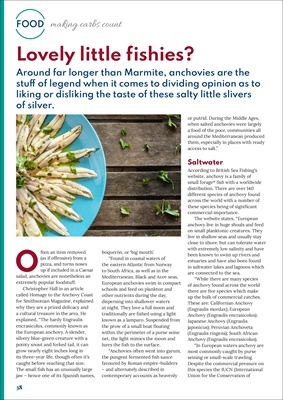
38
FOOD making carbs count
Lovely little fishies?
Around far longer than Marmite, anchovies are the
stuff of legend when it comes to dividing opinion as to
liking or disliking the taste of these salty little slivers
of silver.
Often an item removed
(as if offensive) from a
pizza, and turns noses
up if included in a Caesar
salad, anchovies are nonetheless an
extremely popular foodstuff.
Christopher Hall in an article
called Homage to the Anchovy Coast
for Smithsonian Magazine, explained
why they are a prized delicacy and
a cultural treasure in the area. He
explained, "The hardy Engraulis
encrasicolus, commonly known as
the European anchovy. A slender,
silvery blue-green creature with a
pointy snout and forked tail, it can
grow nearly eight inches long in
its three-year life, though often it's
caught before reaching that size.
The small fish has an unusually large
jaw - hence one of its Spanish names,
boquerón, or 'big mouth'.
"Found in coastal waters of
the eastern Atlantic from Norway
to South Africa, as well as in the
Mediterranean, Black and Azov seas,
European anchovies swim in compact
schools and feed on plankton and
other nutrients during the day,
dispersing into shallower waters
at night. They love a full moon and
traditionally are fished using a light
known as a lamparo. Suspended from
the prow of a small boat floating
within the perimeter of a purse seine
net, the light mimics the moon and
lures the fish to the surface.
"Anchovies often went into garum,
the pungent fermented fish sauce
favoured by Roman empire-builders
- and alternately described in
contemporary accounts as heavenly
or putrid. During the Middle Ages,
when salted anchovies were largely
a food of the poor, communities all
around the Mediterranean produced
them, especially in places with ready
access to salt."
Saltwater
According to British Sea Fishing's
website, anchovy is a family of
small forage* fish with a worldwide
distribution. There are over 140
different species of anchovy found
across the world with a number of
these species being of significant
commercial importance.
The website states, "European
anchovy live in huge shoals and feed
on small planktonic creatures. They
live in shallow seas and usually stay
close to shore, but can tolerate water
with extremely low salinity and have
been known to swim up rivers and
estuaries and have also been found
in saltwater lakes and lagoons which
are connected to the sea.
"While there are many species
of anchovy found across the world
there are five species which make
up the bulk of commercial catches.
These are: Californian Anchovy
(Engraulis mordax); European
Anchovy (Engraulis encrasicolus);
Japanese Anchovy (Engraulis
japonicus); Peruvian Anchoveta
(Engraulis ringens); South African
Anchovy (Engraulis encrasicolus).
"In European waters anchovy are
most commonly caught by purse
seining or small-scale trawling.
Despite the commercial pressure on
this species the IUCN (International
Union for the Conservation of